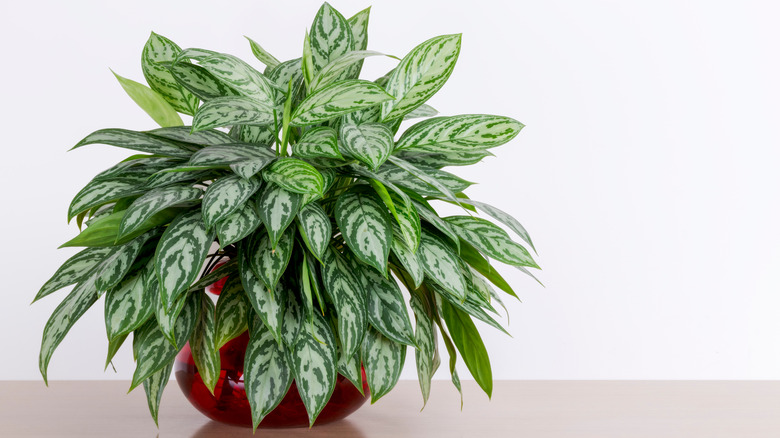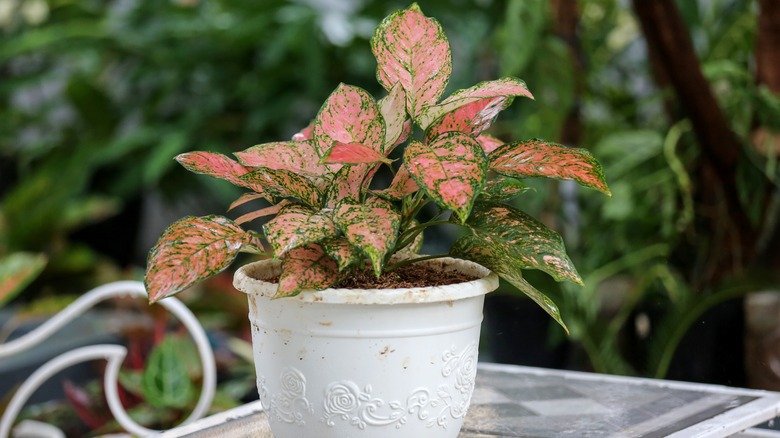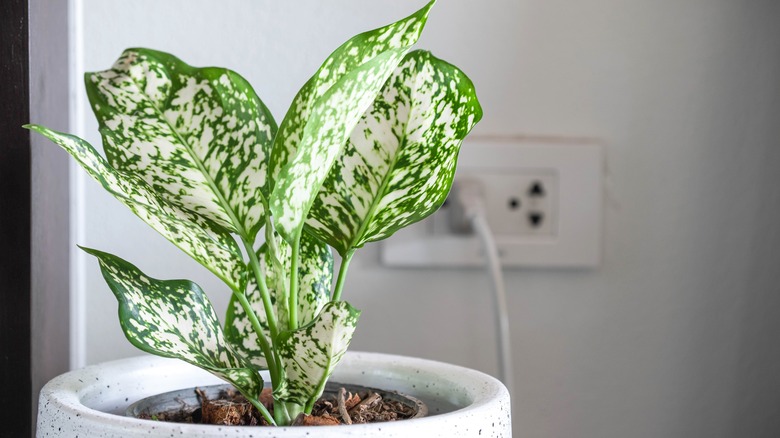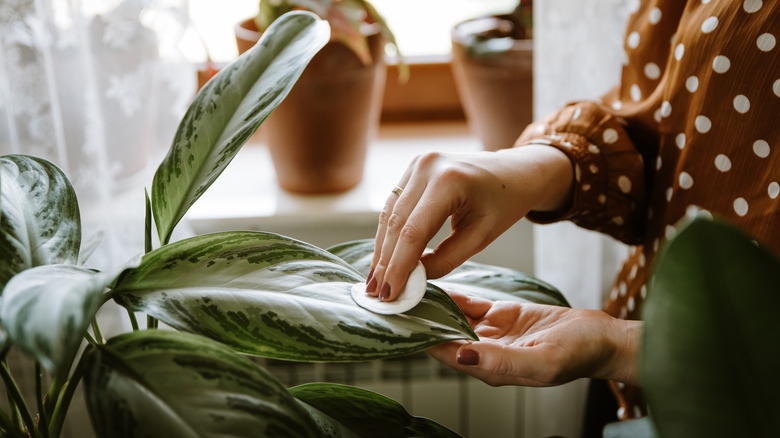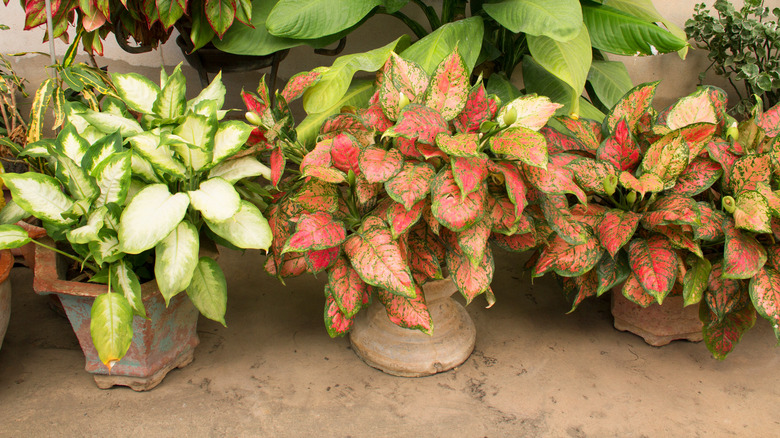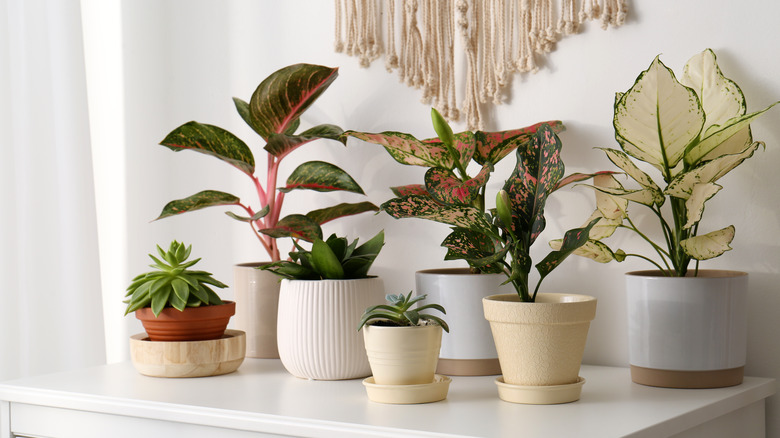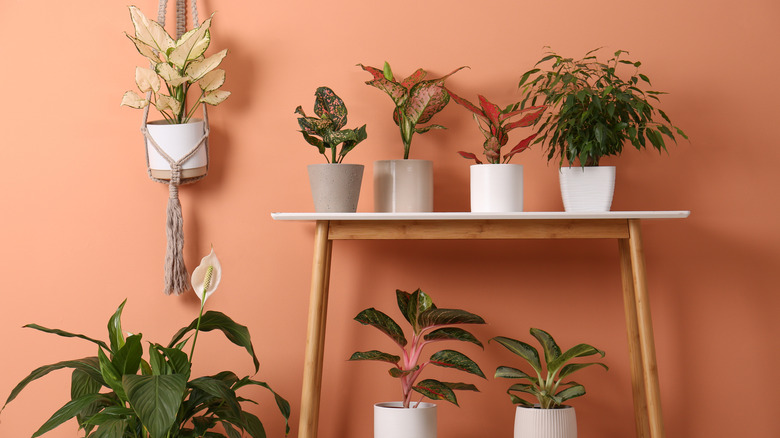How To Grow And Take Care Of Chinese Evergreens
Chinese evergreens, or aglaonema, are a houseplant species native to the tropics and subtropics of Asia, according to House Plants Experts. These houseplants come in a few hybrid varieties with different leaf colors, variegations, and sizes. They also have the potential to produce small spathe flowers that resemble that of a peace lily, given their care needs are met.
Chinese evergreens are a popular choice amongst houseplant lovers. For one, they are an easy to care for plant, and flower they easier than most houseplants, meaning they are an excellent project for beginners. They are also a great addition to any room, with full foliage, dark green leaves, and uniquely colored and patterned variegations. That being said, they are toxic and should be kept out of reach of children and pets.
With a variety of benefits, both literal and visual, the Chinese evergreen is an excellent plant to add to your indoor garden. Read on to learn how to care for this tropical plant.
How to use Chinese evergreen in garden
Chinese evergreen plants are native to tropical rainforests in Asia and, as such, are not often grown outdoors in the U.S. They can be sustained in USDA hardiness zones 10 to 12, according to HGTV, though. This generally covers Southern California and Florida, as well as Hawaii. More specifically, this means that temperatures never dip below 55 degrees.
If you live in an appropriate climate, Chinese evergreens can be grown outside. They prefer to be shaded and should not be in any direct sun rays. City and Garden said the plant can enjoy a few hours of indirect morning sun, though. Your soil will also need to be amended so that it is slightly acidic, well-draining, and fertile — consider adding humus or other organic matter. Outdoors, the plant will also need to be kept more moist and humid than indoors.
HGTV also said Chinese evergreens can be grown outdoors with companion plants such as pothos, ZZ plants, and snake plants. In warmer, more tropical climates of the U.S., it is not uncommon to see people landscape around the exterior of their homes or in small tropical gardens with these plants.
How to grow Chinese evergreen
Chinese evergreens are a very common and popular houseplant, meaning you shouldn't have any issue finding one at your local garden center. If you would like to grow a new plant, though, that can be done via propagation. To begin propagation, you will first need cutting from a mature plant. These can be purchased online for rarer varieties, taken from your own existing plant or that of a friend's, and sometimes garden centers are willing to let customers take home cuttings (but be sure to ask first!).
To get your own propagation going, look for a stem at least 6 inches long. Using clean scissors or gardening shears, cut off the stem at the base. Collect a few of these (but be careful the mother plant doesn't start to look too thin). Gather a few glass jars and fill them with distilled or filtered room temperature water. Consider adding a pump or two of liquid fertilizer. Add a cutting to each jar, and keep them by a windowsill, but away from direct sun. Refresh the water every week or so, and you should see roots forming in a few weeks, according to Apartment Therapy. They're ready to transplant when the roots are a couple of inches long.
Another way to propagate the plant is during repotting. The plant may grow offshoot, baby plants that are not connected to the mother root system. Gently separate them and replant them in soil.
How to care for Chinese evergreen
Chinese evergreens are most popular due to their low maintenance care needs. Beginning with watering, Chinese evergreens are relatively moderate drinkers. According to Gardening Know How, these plants prefer to be left to dry out between waterings, at least until the first inch or so of the soil is completely dry. They are slightly tolerant of neglect but don't push it. These plants are known not just to tolerate but thrive in low light conditions. They can handle up to indirect bright light.
Chinese evergreens also benefit from being fertilized just a few times during their growing season (spring to early fall) with a liquid houseplant fertilizer. You should also take care to make sure the plant's large fronds don't accumulate dust or dirt, which can attract spider mites, aphids, and other common houseplant pests. Using a microfiber cloth, wipe it down with water. To add extra pest prevention, consider wiping the leaves with neem oil diluted with water. Alternatively, give the plant a shower every now and then, letting a gentle stream of water clean the leaves.
If you meet all the needs of your Chinese evergreen, you may even be rewarded with a small flower. The flower resembles that of a peace lily and will typically bloom in the spring or summer, though it can appear whenever. Trim it off when it dies so it won't rot and attract pests.
Chinese evergreen varieties
One of the appeals of owning a Chinese evergreen is that they come in a multitude of hybrid varieties. They all have the same care needs but offer an array of visual differences. Some of the varieties come in gorgeous, earthy greens, some with speckles of pink, some in silver hues. Regardless of which type you get, you're sure to have a gorgeous addition to your houseplant collection. Here are just a few of those hybrid varieties, according to HGTV:
- Dazzling Gem — This variety is identifiable by its dark green leaves with splotches of light to dark pink, which can appear in freckles or taking over the whole leaf.
- Aglaonema "Maria" — This variety is quite distinct, almost resembling a snake or zebra plant with long pointed leaves and white leaf variegation.
- Silver Queen — Also known as Painted Drop Tongue, has a silver variegation against dark green leaves, almost giving it a frosted appearance.
- Siam Aurora — One of the most unique varieties, this plant's leaf variegation is reversed, with a dark green interior and pink border and veins.
- Silver Bay — This variety is similar to silver queen, except that the silver variegation appears almost an opaque swipe of paint.
Is Chinese evergreen toxic?
Chinese evergreens are toxic to humans and animals. The ASPCA listed the plant as toxic to cats and dogs due to insoluble calcium oxalates. When ingested, symptoms can include oral irritation and swelling, excessive salivation and drooling, vomiting, and difficulty swallowing. The plant's sap and juices are also toxic, so your pet getting into the plant without eating it can also be a cause for concern. If your pet has somehow come in contact with the plant, call your vet immediately and monitor symptoms. If you catch your pet eating the plant, consider inducing vomiting.
The plant is also toxic to humans, per HGTV. Keep them out of reach of small children. While you may not be planning on snacking on the plant anytime soon, touching the plant if it has secreted any juice or sap can cause contact dermatitis. This should only result in mild irritation but can be avoided by wearing gloves and washing your hands after touching the plant. It can also be dangerous if the juice gets in your eyes.
How to repot Chinese evergreen
Chinese evergreens should be repotted every two years or so. One tell-tale sign it's time to repot is if the roots are growing out of the container, either from the surface or bottom. The plants prefer to be a little rootbound, but not too much. Older plants should be removed from their pot, have their roots cleaned up, and soil refreshed every two years or so, regardless of whether they need more space.
To begin repotting your plant, assess if it needs more room for the roots. If yes, go up a pot size, about 2 inches. Prepare your new soil. Apartment Therapy recommended a peat-based potting mix or amending a regular potting mix with perlite, though a regular potting mix will do just fine in a pinch. Add the soil to your pot, about 1/4 of the way up.
Remove your Chinese evergreen from its current pot and assess the roots. Since they like being a little root bound, gently break up the outer layer only, removing any old dirt and cutting off any dead roots (healthy roots will be whitish-yellow and firm. At this point, you can remove any offshoot plants if you want to. Add the plant to the new container, and fill with soil to the top. Water thoroughly to expose air pockets and fill with more soil. Water again and let drain.
